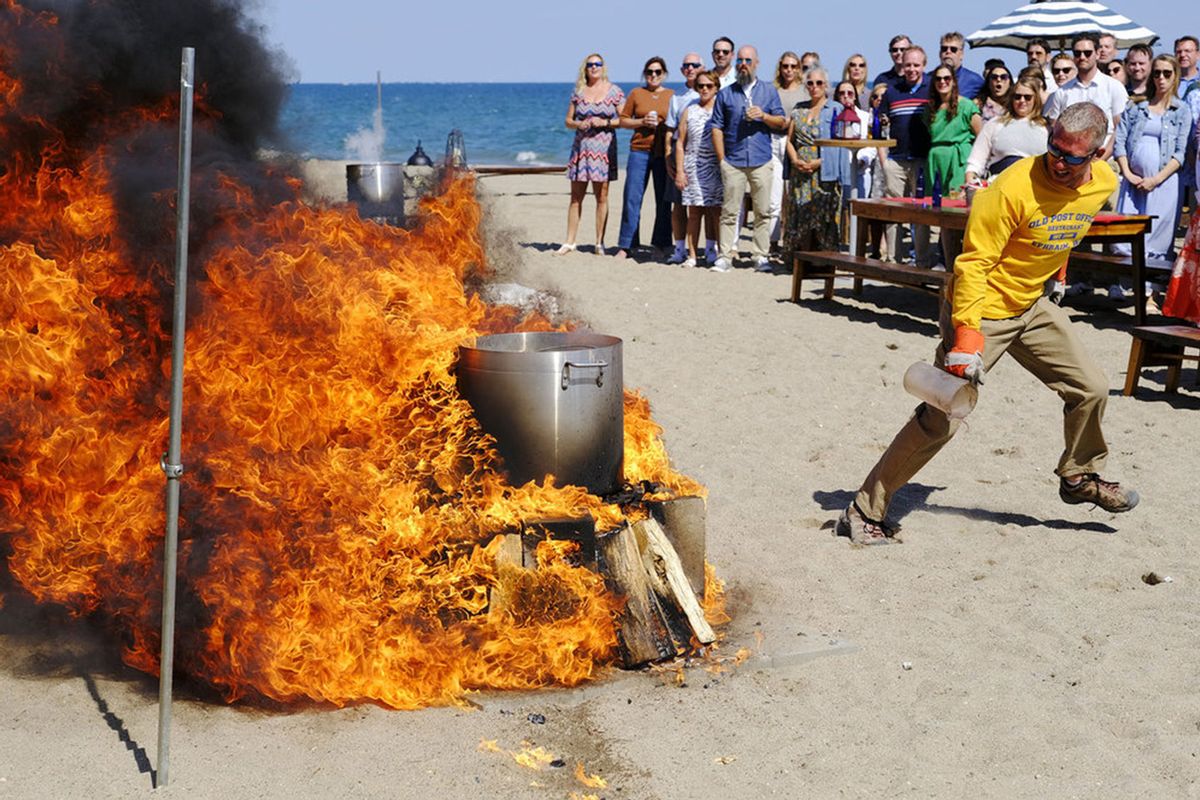“Top Chef” contestants had to put their spin on a classic Door County fish boil — but what is it?

While I wasn’t especially fond of this week’s “Top Chef” because of an unfortunate boot, some lackluster food, some odd alumni decisions, and my favorite cheftstant having to jet to urgent care for a deep cut, the episode did indeed elucidate two fascinating Wisconsin food customs that were, up until this week, entirely foreign to me: fish boils and meat raffles.
While the meat raffle is somewhat common sense, the fish boil is . . . anything but.
As “Torch” — the essential master of ceremonies, kerosene-thrower, master boiler and Fish Boil expert present in the episode — shared, a fish boil involves someone throwing kerosene on a large pot of boiling water (or other liquids) in which fish is being cooked relatively quickly. The kerosene conflagration causes the water itself to boil over, releasing a fireball and enormous amounts of smoke, which in turn also happens to remove all scum and impurities, allowing for the fish to then be served without unappetizing crud decorating it.
Personally, from a culinary perspective alone, the idea of a fish boil isn’t the most appetizing; as Dan noted in the episode, he had been taught that fish should be poached, not boiled. For me, the major issue is the lack of texture. Boiled fish — no matter what it’s boiled in or flavored with — is, at the end of the day . . . boiled fish. While the sides allow for some excitement and textural differentiation, the focus of the custom is most certainly on the fish itself.
While the food may not be exorbitantly appealing to me, though, the history of the fish boil itself was really fascinating.
As host Kristen Kish explained when she told the cheftestants about the elimination challenge, fish boils are a common, cherished occurrence in Wisconsin, particularly in Door County. The challenge itself took place on a beautiful beach complete with Torch acting as kerosene-thrower. (In the Milwaukee Journal Sentinel, Rachel Bernhard writes about her experience in Grant Park Beach when the challenge was filmed, noting that while the beach setting was lovely, the challenge honoring a Door County custom didn’t take place in Door County).
While a traditional tourist custom, fish boils often occurr at various Wisconsin restaurants throughout the year, with many locals enjoying the familiar flavors — and the requisite heat from the boil-overs and the smoke billowing, In this video, Torch, whose real name is Jeremy Klaubauf, explains the custom: a fish boil is “kind of a simple meal: Fresh, locally-caught whitefish that we buy from local fishermen here, boiled potatoes, baby onions, you put melted butter all over it, salt, it’s all cooked in a big cauldron outdoors using firewood as your main heat source. [It] would’ve been done by Swedish and Norwegian loggers back in the 1800s.”
Want more great food writing and recipes? Subscribe to Salon Food’s newsletter, The Bite.
Some, though, call into question the true origins and inspirations of what became the now widely-known Door County fish boil. In “Sagamité and Booya: French Influence in Defining Great Lakes Culinary Heritage,” Janet C. Gilmore of the University of Wisconsin states that while many attribute the fish boil to Scandanavian fishermen, many other groups, such as the indigenous and Native peoples of the area, as well as other European immigrants, all consumed lots and lots of boiled fish at the time.
“Notably, however, boiling chunks of lake trout and whitefish without much in the way of seasoning or other ingredients was a common meal for the western Great Lakes fishing Indians, Ojibwas, Odawas, and Hurons especially,” Gilmore wrote.
This is distinct from a “fish booya,” which is “more like a soup than the fish boil incorporating other vegetables like carrots, onion, corn and celery, as well as even some chicken booyas, which do away with the fish entirely. Gilmore notes that the “booya” culture has a lot in common with succotash, mulligans, burgoos, and even turtle soup, as in a “catch-all, ‘everything-but-the-kitchen-sink'” type of nourishing meal.
According to Gilmore, traditional fish boil kettles generally hold two stainless steel baskets, which can be “lowered and raised easily from the boiling water, and which protect the ingredients from disintegrating as they are cooked and then retrieved.”
“The handles of the top basket fit inside the handles of the lower,” she wrote. “Potatoes first, and then onions, go in the lower basket, and fish in the upper one. Each ingredient has a different cooking time, with potatoes of fairly uniform size added first, smallish onions second, and fish for the last 5 to 8 minutes or so.”
Of course, with so many variables — from smoke, fire, ash, firewood, heat and wind — fish boils can be a particularly challenging task from a logistics perspective, and it’s also quite taxing physically, especially with hauling these enormous cauldrons. A traditional fish boil is certainly more streamlined than the dishes we saw on “Top Chef,” with simple potatoes and corn on the side. These are obviously classic flavors and ingredient combinations, which bring to mind those steampots that various seafood chains sell, oftentimes containing seafood of all sorts, plus corn, potatoes and sometimes sausage.
“The salt — about a pound or two for every gallon of water — helps in the boiling process. It causes everything to float, like the fish oils and debris from the vegetables that we don’t want to eat,” the Milwaukee Journal Sentinel’s Rachel Bernhard wrote. “With the water goes the unwanted oil and debris, and once the fish and potatoes are filtered out, it’s time to eat.”
Rumor has it that the fisherman at the “turn of the 20th century” turned to fish boil for simple reasons: It was a cinch to feed a large group this way, with locally caught seafood and classic accouterments. Fish, oftentimes coupled with onions, corn, potatoes or other vegetables, easily became a full, nourishing meal for hungry workers, and also sometimes their families. Bernhard notes that the idea of a fish boil as an event or hosted at a restaurant didn’t occur until the 1960s, though, when Door County’s Viking Grill and White Gull Inn started to embrace and celebrate the local custom in a restaurant setting for patrons.
The official Door County website calls them a “one-of-a-kind epicurean event,” noting some other sides that aren’t as often mentioned, from lemon wedges, coleslaw and bread to “fresh-baked Door County cherry pie” for dessert. Gilmore also acknowledges the spectacle aspect of the fish boil, the way that it became “a bit of public theater” while simultaneously also helping to feed large crowds, host tourists, foster a sense of community and utilize the local fish and produce.
So while I may not be enamored with the food from an epicurean perspective, there’s so much more to it: The lore and history of the custom is as rich as can be. As Gilmore wrote, “it is especially important to include the broader region’s indigenous peoples, especially in the Green Bay and Upper Peninsula area, the former nexus of the fishing Indian domain, where fish in many forms was once an important ingredient in the one-pot boiled meal.”
Read more
about this topic


